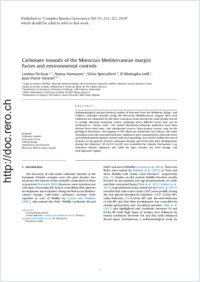Carbonate mounds of the Moroccan Mediterranean margin: Facies and environmental controls
- Terhzaz, Loubna Group of research ODYSSEE, Faculty of Sciences of Rabat, Mohammed-V University Rabat, Morocco
- Hamoumi, Naima Group of research ODYSSEE, Faculty of Sciences of Rabat, Mohammed-V University Rabat, Morocco
- Spezzaferri, Silvia Department of Geosciences, University of Fribourg, Switzerland
- El Lotfi, Mostapha ENSET, Mohammed-V University of Rabat, Morocco
- Henriet, Jean-Pierre Department of Geology & Soil Science, Ghent University, Belgium
-
01.07.2018
Published in:
- Comptes Rendus Geoscience. - 2018, vol. 350, no. 5, p. 212–221
English
Sedimentological and geochemical studies of boxcores from the Brittlestar Ridge I and Cabliers carbonate mounds, along the Moroccan Mediterranean margin, show that sediments are composed of cold water scleratian corals and micritic mud, muddy micrite or muddy allochem limestone matrix, outlining seven different facies that can be attributed to “cluster reefs”. The mixed siliciclastic/carbonate sediments have been derived from both extra- and intrabasinal sources. Extra-basinal sources may be the geological formations outcropping in the Moroccan hinterland and Sahara, the latter including corals and associated bioclasts. Sediments were transported by wind and rivers and redistributed by bottom currents and local upwelling. Our results confirm the role of tectonics in the genesis of these carbonate mounds and reveal that their developments during the Holocene (10.34–0.91ka BP) was controlled by climatic fluctuations (e.g. Holocene Climate Optimum and Little Ice Age), eustatic sea level change, and hydrodynamic regime.
- Faculty
- Faculté des sciences et de médecine
- Department
- Département de Géosciences
- Language
-
- English
- Classification
- Geology
- License
-
License undefined
- Identifiers
-
- RERO DOC 322880
- DOI 10.1016/j.crte.2018.04.003
- Persistent URL
- https://folia.unifr.ch/unifr/documents/307034
Statistics
Document views: 115
File downloads:
- pdf: 262
